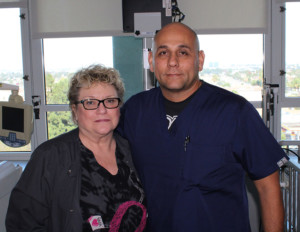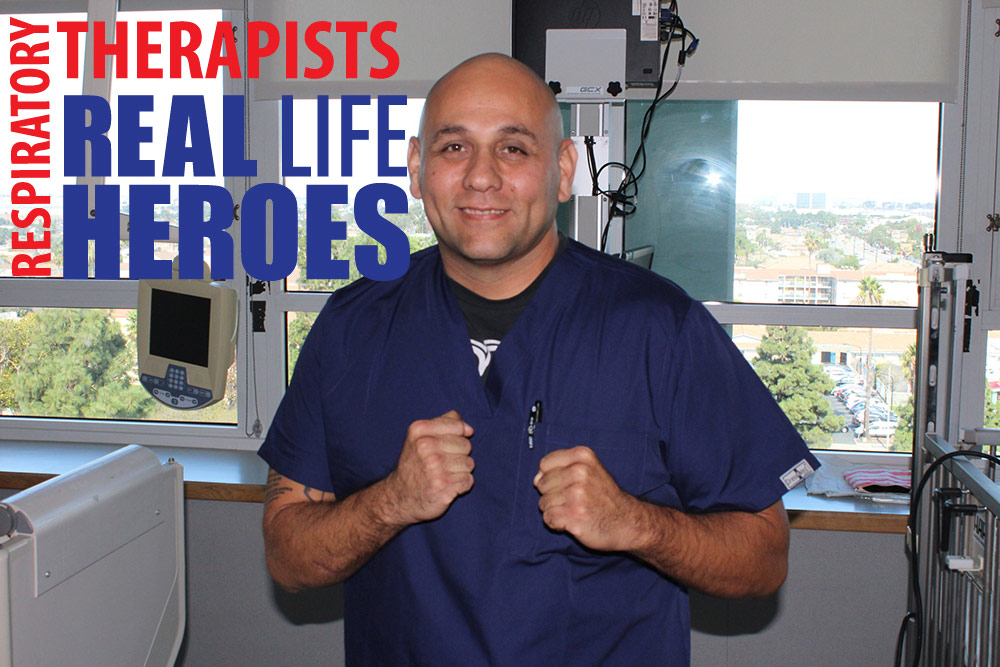This week is Respiratory Care Week and the theme for 2016 is “Real Life Heroes”. It is a time celebrate the respiratory therapists among us and raise awareness for improving lung health around the world. Gilbert Medina has been at Harbor for twelve years and has been a respiratory therapist for sixsteen years. He is a LA County veteran who also works part time at LA County + USC in trauma and ICU.
What does a Respiratory Therapist do?
Gilbert: We provide artificial life support with ventilators for patients who can’t breathe on their own — patients coming out of surgery, suffering from trauma, newborns who just need a little bit of help. We also support patients such as asthmatics who need medication to open their lungs, people with emphysema who need added pressure to help them get air out.
What’s it like in an intensive care situation?
Gilbert: It’s kind of chaotic. There are maybe 20-30 people sometimes. This is a teaching facility so there are people there learning, observing you. When you’re first introduced to that kind of environment, your adrenaline is pumping a lot in that in that kind of situation but the longer you do it, the more calmly you go through the steps. You realize that what you’re doing is the most important part – you go into tunnel vision and only focus on your job for the most part to make sure that you’re doing what you’re supposed to be doing.
What drives you?
Gilbert: Making a difference. Sometimes you get there and you’re the only medical professional on the scene and the baby is out and blue. There are people who are delivering a baby but not may be trained to resuscitate a baby or not proficient in resuscitation. There’s been many occasion and the primary caregiver to a newborn who is either puseless or not breathing and I think of all the aspects of my job, that’s what I enjoy the most because you actually do make a difference and see immediate results. The baby starts crying and everyone else starts crying and I even hold back the tears.
 Who is another Respiratory Therapist you work with and admire? What do you admire about that person?
Who is another Respiratory Therapist you work with and admire? What do you admire about that person?
Gilbert: Rhonda here is a wonderful therapist. She has years of experience and she is diligent. She gives a lot of support, not just me but the entire unit. She is readily available and a wealth of experience and she doesn’t shake or frazzle easily.
How is Respiratory Therapy evolving?
Gilbert: We’re getting smarter machines which requires constant Continuing Education. More and more studies are coming out regarding the benefits and damage that can be done by all the smart technologies that are coming out.
At times there can be over reliance because it is easy to focus on the screen and numbers. At the end of the day, we’re treating the patient. Always focus on the patient. Always focus on how does the patient look. If the machine says the patient is fine but the patient is blue, it’s not correlating. And vice versa. It always has to come down to how does the patient look.
What’s something that most people don’t know about Respiratory Therapy?
Gilbert: There are a lot of non-vital responsibilities such as stocking equipment. We have a therapist down stairs who is cleaning and monitoring equipment. This is a full service hospital so we do every aspect of respiratory care. We also have Continuing Education and of course we do our yearly competencies.
How do you spend time outside of the hospital?
Gilbert: I spend a lot of time with my daughter. I work out and train in Muy Thai. I hang out with friends, family. I love to travel when possible.
To learn more about Respiratory Therapy at American Association for Respiratory Care.

